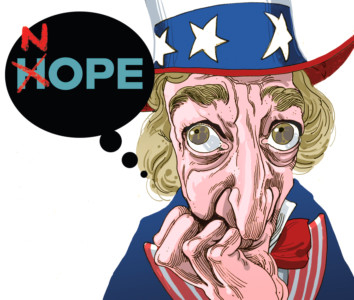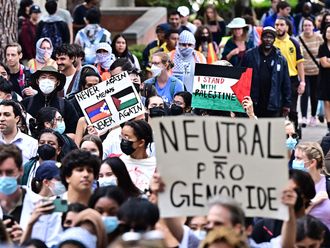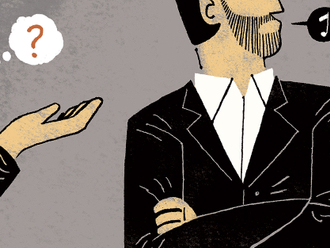
A week out from a critically important United States midterm election, I’m struck by the role that fear has played in getting us to this moment.
Diagnosing how fear became such a powerful political force is tricky because the minute you point fingers, you trigger precisely the divisive fight that keeps America stuck in this dark hole. This leads some to try to ascribe blame to both sides, but that’s often just a thin tactic to try to sound balanced.
In fact, over the past two years, US President Donald Trump’s strategy has become transparent: Get the potentially politically powerful working-class to fear each other.
As long as groups whose political alignment could seriously improve, their lot are at each other’s throats, the political machine can quietly go about its business.
The accompanying media strategy is equally key to the success of the agenda: Keep the actual policies off the front pages, and when they show up there, discredit them. Keep the fearmongering part on the front pages.
Adam Serwer, writing in the Atlantic, correctly describes this powerful strategy: “Trump considers the media ‘the enemy of the people’ only when it successfully undermines his falsehoods; at all other times, it is a force multiplier, obeying his attempts to shift topics of conversation from substantive policy matters to racial scaremongering.” You could hope members of Trump’s party might care about the future enough to mediate the damage, but their political cowardice of standing up to Trump and their allegiance to the tax cut/deregulation agenda renders them hopeless.
This all sounds awfully cynical, and it is, but if that’s all it was, it wouldn’t be so effective. A key element of Trump’s endless fear campaign is making a group with a disproportionate electoral power (thanks to both Senate apportionment and the electoral college) — older, non-urban, white voters in swing, rust-belt states — feel like they’re finally being heard. This empathetic embrace not only includes acceptance and validation of their fears and prejudices. It also targets establishment politicians as dismissing these voters’ concerns and giving jobs and incomes that they believe should be theirs to immigrants and people of colour.
Some readers may cringe at the claim of Trump’s empathy with this group, but to do so may well be to discount what may be his only genuine, heartfelt sensibility. He connects with his base because he too has been (and is even more so now) looked down upon by elites who discredit his intelligence, wealth and ability. He’s not just riling up his base at those rallies; he’s sharing their anger at being viewed as “deplorable”.
It’s an incredibly effective strategy. Fear of immigrants, “the caravan” embedded with “Middle-Easterners”, people of colour, Muslims, the government, “globalists”, environmentalists, and so on, is, under economic conditions that prevail today (economic insecurity in a period of global and technological change), political rocket fuel.
But it has two fundamental problems, two flaws in its DNA that ultimately destroy its host, two unstable ingredients that render its powerful fuel combustible. First, it is politically non-representative, and second, it is model for seizing power, not for governing.
Regarding governing, those in power haven’t a clue as to what to do about health care, education, climate change, infrastructure, poverty, inequality, retirement security, housing, trade, geopolitics, or any other of the challenges for which complex societies need functioning, amply funded governments. They only know how to use fear to stay in power, and how to use that power to redistribute wealth upwards.
As for representation, even when you combine them, Trump’s base voters and the high-end beneficiaries of the Republican agenda are a minority of the electorate (here again, structural aspects of America’s antiquated system reinforce this problem). The rest of us are getting increasingly angry about the extent to which national politics fails to represent Americans. After the Judge Kavanaugh debacle, I asked whether US politics still had the capacity to self-correct this flaw. The most recent incidents of domestic terror and murderous hate crimes only increase the urgency of that question.
Before the current dystopia set in, I had worked in the previous US administration, but until I sat down to write this op-ed, even I — perhaps because of my privileged position as a white man — didn’t fully understand the meaning of “the audacity of hope”. As I read that phrase today, it speaks to the audacious, if not ahistorical, hope that the power of unifying with others based on our commonalities will be strong enough to block the fearmongers from exploiting our differences.
Young people may not know this, but for a precious minute, such hope prevailed. Even today, many of us remember it vividly and long to recover it. The politics of fear has not killed our hope. But fear is once again proving to be a powerful adversary, and not just in America.
Next Tuesday is more than “a referendum on our future”. It is a test to see whether hope has any life left in it, or whether fear has, at least for now, overtaken it.
— Washington Post
Jared Bernstein, a former chief economist to US vice-president Joe Biden, is a senior fellow at the Centre on Budget and Policy Priorities and author of The Reconnection Agenda: Reuniting Growth and Prosperity.








